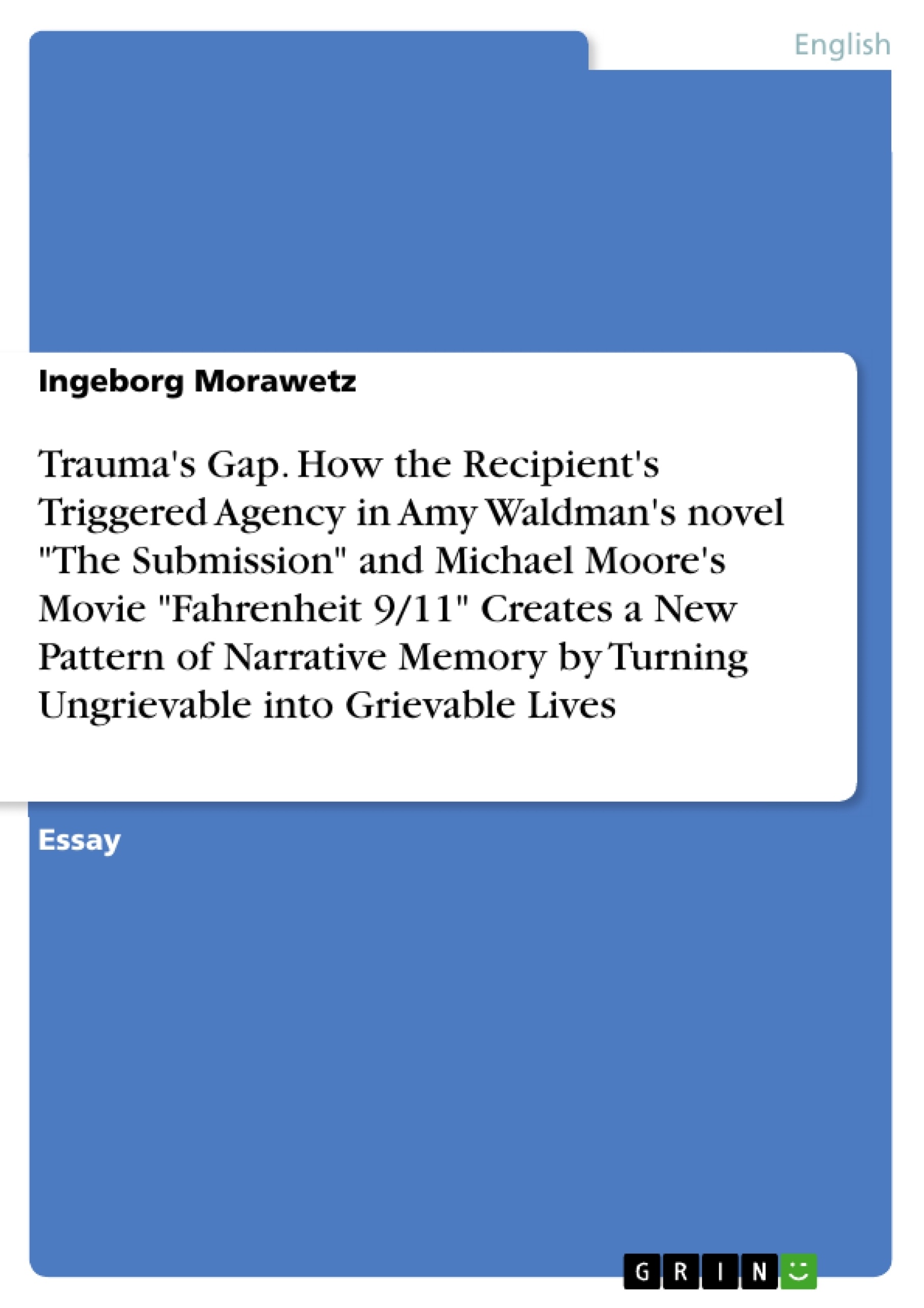This paper argues that, contrary to politics and news coverage, both Amy Waldman's novel "The Submission" and Michael Moore's movie "Fahrenheit 9/11" give the audience the chance to not rationally understand, but to emotionally recognize the "other" as grievable within the representational gap that is created through the narrated relation of the “I” to the “face”. This emotionally recognized narrative of the other can become part of the narrative memory into which traumatic recall should be turned, and therefore also is more
successful in the overcoming of trauma's gap than the public medial narrative.
After the attacks on the World Trade Center on September 11th, 2001, two major narratives emerged: The trauma of the US citizens and the defense against the evil other. Both are connected on a psychological and political level. The “us vs. them” dichotomy, the traumatized good Americans against the evil Muslims, existed before the attacks and was reinforced afterwards.
The trauma of the individual American was partly instrumentalized and militarized for political purposes, leading to a perception of the Muslim other not only as evil, but also as ungrievable. Judith Butler discusses the notion of the “ungrievable other” in her publication Precarious Life. She sees the attacks as a chance to change the political and individual dichotomy of “us” and “the other”, and therefore of grievable and ungrievable lives. Butler argues that the “recognition of the other” (Butler 34-44) could prevent further terrorist attacks and wars by pursuing the notion of a two-sided vulnerability. By using Levinas' theory of the “face” she shows how failed representation of and failed identification with the other can lead to experiencing it as grievable by creating a difference or a gap in the relation of it to the self, synonymously the human-being that is recognized as such, the first-personnarrative, the “I” or the “us”.
Amy Waldman's novel "The Submission" and Michael Moore's movie "Fahrenheit 9/11" treat the
other in particular narrative, compositional and structural ways that create this gap. Both works are
perceived as in between fiction and non-fiction and were controversially discussed, thus creating an
uncertainty in readers and viewers about their expectations, and putting them into a state of agency
and action by demanding an opinion.
Inhaltsverzeichnis (Table of Contents)
- Introduction
- The Medial Pattern of the Ungrievable Other: An Unsuccessful Working Through
- The Submission and Fahrenheit 9/11: Turning “The Other” into a Grievable Human Being
- Amy Waldman's The Submission
- Michael Moore's Fahrenheit 9/11
- Conclusion
Zielsetzung und Themenschwerpunkte (Objectives and Key Themes)
This essay investigates the portrayal of the "ungrievable other" in the aftermath of 9/11, particularly in Amy Waldman's novel *The Submission* and Michael Moore's film *Fahrenheit 9/11*. The author argues that these works, while controversially perceived as occupying a space between fiction and non-fiction, offer a means for audiences to emotionally recognize the other as grievable. This process of recognition, according to the essay, is essential for overcoming the gap created by trauma and promoting a more inclusive and empathetic narrative memory.
- The concept of the "ungrievable other" and its role in shaping narratives of 9/11.
- The use of media and its impact on the formation of collective memory and trauma.
- The power of narrative in bridging the gap between "us" and "them" by promoting emotional recognition.
- The role of "the face" in Levinas' theory and its application to understanding the relationship between self and other.
- The importance of working through trauma through narrative and the potential of media to facilitate this process.
Zusammenfassung der Kapitel (Chapter Summaries)
The introduction sets the stage by outlining the two dominant narratives that emerged after 9/11: the trauma of American citizens and the defense against an evil "other." This "us vs. them" dichotomy, according to the essay, was reinforced by the attacks and fueled by political agendas. The essay further introduces the notion of the "ungrievable other" as a key theme, highlighting Judith Butler's argument that failing to recognize the other's vulnerability can perpetuate violence and hinder healing. The author suggests that both *The Submission* and *Fahrenheit 9/11* contribute to a different kind of narrative that aims to bridge this gap by fostering emotional recognition of the other.
Chapter 2 explores the process of working through trauma and the role of media in shaping narratives of collective memory. The essay draws on the work of Mieke Bal, who defines traumatic recall as a fragmented and often unspeakable experience that needs to be transformed into a coherent narrative memory through active participation in storytelling. This chapter argues that the media coverage of 9/11 and the subsequent Iraq War, while serving to provide a narrative structure, ultimately hindered individual processing of trauma by reinforcing a sense of American supremacy and failing to acknowledge the suffering of the "other."
Schlüsselwörter (Keywords)
This research essay explores the concepts of trauma, memory, and narrative in the context of 9/11 and its aftermath. Key terms include the "ungrievable other," narrative memory, traumatic recall, symbolic identification, radical effacement, and the "face" in Levinas' philosophy. The essay examines how media, particularly in the form of literature and film, can contribute to the process of working through trauma and bridging the gap between self and other.
- Quote paper
- Ingeborg Morawetz (Author), 2016, Trauma's Gap. How the Recipient's Triggered Agency in Amy Waldman's novel "The Submission" and Michael Moore's Movie "Fahrenheit 9/11" Creates a New Pattern of Narrative Memory by Turning Ungrievable into Grievable Lives, Munich, GRIN Verlag, https://www.grin.com/document/352735



